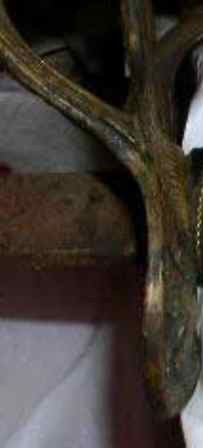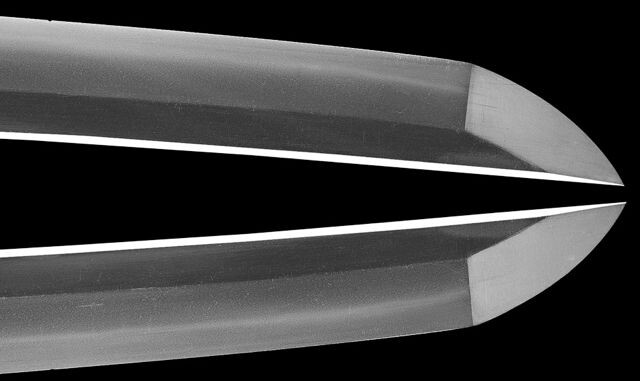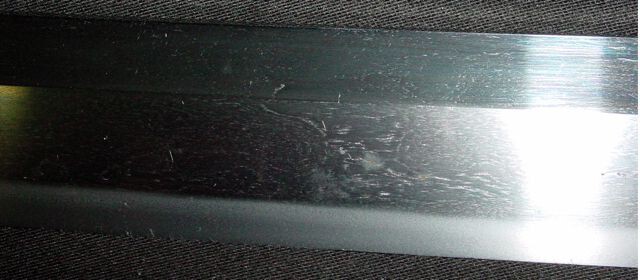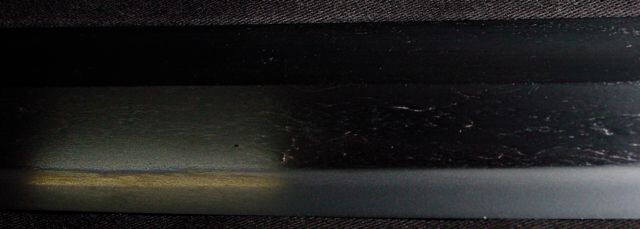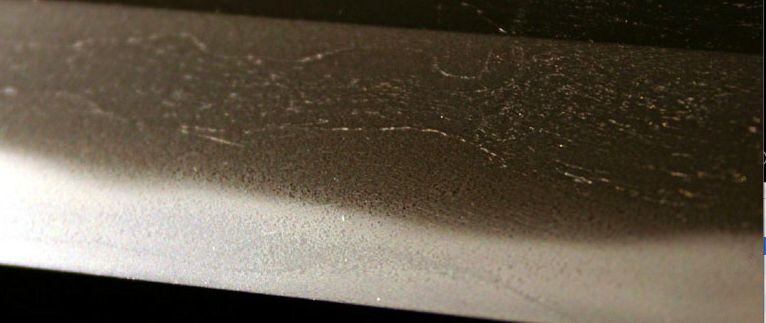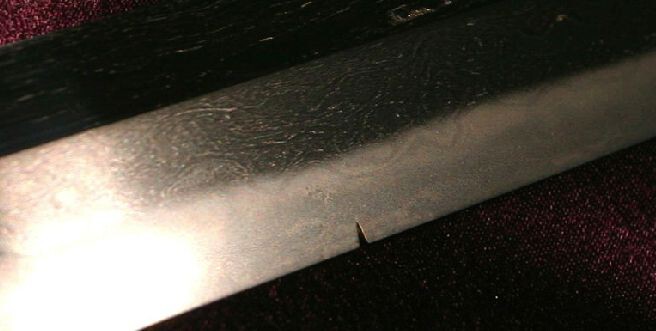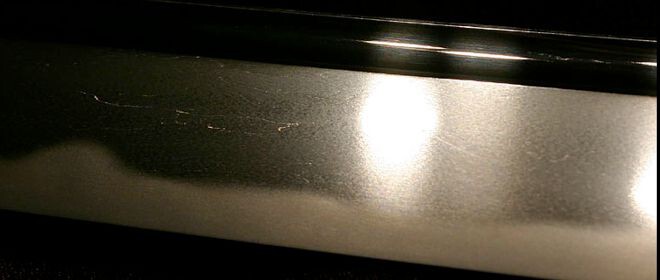-
Posts
1,029 -
Joined
-
Last visited
Everything posted by Eric H
-

Can somebody identify this sword please?
Eric H replied to kilsor's topic in Military Swords of Japan
-
It's the same..."two is better sewn" Eric
-
YES...a real drama for sharing Eric
-
Dear Kristian Franz Konrad, Congratulations...sorry, not to you but to the seller. My best wishes for a successful study...and please keep us informed of what you have found. Sincerely, Eric
-
Thanks Brian, I understand Eric
-
-
The process called saiha or yakinaoshi is executed on blades who have been damaged by fire, the hardend steel of the cutting edge became soft, the sword was no longer useful as a weapon. Yakinaoshi was performed to restore the hardened edge of those blades, first and foremost making them anew full-fledged weapon....of course also to preserve blades by highly important smiths. As nowbody knows what Yasutsugu thought when doing yakinaoshi, it is most likely, that based on his skill and knowledge, he has restored the hamon nearest to the one of the original maker, i.e in his style. This might be also an assumption but it‘s logical. Eric
-
The Nambantetsu challenge has already been discussed on several times. It is strange that no member of the JSSUS has deemed it appropriate to bring this article for information of our members. Thank you Frank Eric
-
Shodai Yasutsugu was an expert in performing yakinaoshi, determined not only to restore the swords beauty but also its functionality...if this was needed, that goes without saying. http://www.nihontocraft.com/Yakinaoshi.html Yakinaoshi (re-temper), a very interesting article on the topic. Eric
-
When looking at the pictures kindly provided by Carlo, no similarity in comparison with the „Hyotan“ shape ingot is seen, and in the following article by J.D. Verhoeven and A. Pendray, Muse, 1998, those wootz ingots are described: „each ingot weighed about one pound“ or „as the quantities produced were in kilogram size cakes“. Further I cannot see any evidence in this article, that any trade with wootz has been made with Japan, the route of destination with wootz was ultimately Persia. It is likely that the age of steel using crucible processes began in India by the pre-Christian era leading to the wootz process. Thus the period spanning 300 BC to AD 1856 is termed as the First Age of Steel, whereby crucible steel making and cementation were two significant processes available for the production of steel. However, as the quantities produced were in kilogram size cakes applications were limited to small tools, cutlery and weapons such as swords. Tatara tama-hagane has been produced in Japan for about 1000 years. It was introduced from Korea in the latter half of the sixth century AD. By the 1660’s the Dutch also became involved in developing the iron industry in the Godavari delta of Andhra Pradesh. Indeed in the 17th century the Dutch Establishment is reported to have shipped from India hundreds of thousands of ingots of wootz steel. The Dutch traded in wootz from the east-coast port of Machilipatnam to Gamroan in Persia. It is believed that one shipment in the l600s alone contained 20,000 wootz ingots, where each ingot weighed about one pound. By the late 1600’s shipments running into tens of thousands of wootz ingots were traded out from the Coromandel Coast to Persia. In fact the range of these accounts coming from various parts of Southern India spread over an area of several hundred square kilometres indicates that the activity of manufacturing wootz ingots and selling them across the seas was almost on the scale of a semi-industrial enterprise in an era prior to the Industrial Revolution. It may continue to be puzzled. Eric
-
Thanks Carlo and Piers for the pictures and explanations. An analysis of an original wootz ingot compared with the known data of Hyotan-shaped Namban-tetsu could perhaps clarify which theory is right. Carlo mentioned the high demand of guns, teppo. The manufacture of gun barrels requires equally large quantities of steel as well knowledgeable gunsmiths for manufacture. There was a teppo factory and a canon reverberatory factory in Nagasaki. What kind of steel did they process? Eric
-
"John A Stuart" We know it was imported to Japan Do we?...perhaps Moriyama san can help and present a document. As add on the chemical analysis of the persian blades compared with those modern Solingen steels, around 1920...in this case those persian blades exhibit an unfavorable amount of phosphor as can be seen. That raise the question, would Japanese swordsmiths use a material that do not correspond to their requirements. You agree this steel is far away from watetsu. BTW in another thread written by omidaijo/Roger Namban tetsu was a highly sought after and expensive commodity...and there were boatloads of highly sought after steel at the backdoor in Nagasaki. Well, I think if Nanban-tetsu was available in such large quantities, why was it so expensive?... Eric
-
Excerpts from Carlo's first link: with shipments of tens of thousands of wootz ingots being sent to places such as Persia. India was not only known during this period for its mastery in making the raw material of steel, but was also highly reputed for its swordsmithy as exemplified by accounts of the unsurpassed excellence of a swordsmith of Thanjavur. A distinction may be made between true Damascus blades in which the layered wavy light-and-dark pattern was an intrinsic property of etched wootz steel and pattern-welded Damascus blades in which patterns were created by welding layers of lower and higher carbon steel such as the Samurai swords of Japan. In this context "pattern-welded Damascus blades...is also to understand wrought iron, the method used by the Europeans. Wootz is a crucibel cast steel (acier de fonte ou cristallisation). It is a unitary product, whose pattern, respectively whose structure was created by crystallization and segregation. The art of the smith was to generate from this raw material coming from India the specific patterns, there are known against 40 different patterns. According to Anossow and Belaiew there were in existence 3 methods to obtain Damascus-steel... We have in Switzerland one of the largest collections of oriental Art in Berne, the collection of Henri Moser Charlottenfels. Henri Moser has sacrificed 4 sabres and 2 knives all from Persia and according to the pattern from the better qualities, to analyze using modern technics at the „Eidgenössische Materialprüfungsanstalt, Zürich“ It is not possible to mention here all the tests and results. Assumed the Portugese transported "wootz" in large quantities, why nothing is seen of this miraculous indian steel in swords, sabres, epees made by the Europeans, Toledo f.e. had a famous reputation. Damascus steel, wootz, from India was exclusively used in India and the Orient (Persia, Afghanistan, Turkey etc.) and hence never in Japan. Eric
-
In my understanding NO... has nothing to do with wootz...wootz was the raw material for oriental damask. Eric
-

S F Show
Eric H replied to tetsugendo11's topic in Sword Shows, Events, Community News and Legislation Issues
John, spectacular photos of that Kiyomitsu, may I ask what camera Kristie was using? Eric -
Very enlightening it is concluded that "Hyotan" shaped Nanban-tetsu steel is not good for forging, "Saijo" shaped Nanban-tetsu steel is good for forging, "Koban"-shaped one is difficult to forgeweld and "Tajo"-shaped one is intermediate. "Saijo" is a square timber-shaped steel, so I was not totally wrong in my guess. Thanks Moriyama san Eric
-
Thanks but no access to the file Eric
-
Interesting, but the measure and the weight? Eric
-
1) Puck size ca. 10 cm/5 cm 2) Ingot ca. 20 x 5 x 2 cm (L-B-H) Eric
-
Konuka hada is associated with swords by the Tadayoshis. Generally the kawagane of their swords is thin and after repeated polishing shingane can be seen occasionally. Pic 1 from a Wakizashi by Tadayoshi III, Mutsu no Kami, in old but intact polish with a small hakobore. Pic 2-3-4 are from a Wakizashi by the same Tadayoshi III, showing shingane, the blade exhibits also mune-ware and one umegane, though not seen in these pics. The pics are enhanced Eric
-
Provided you are an inhabitant of Greece, the VAT is 21.0% have a look at this link...http://www.evz.de/UNIQ128505972702699/doc424A.html Eric
-
link to Takahashi Yoshimune : http://www.japanesesword.com/Images/Swo ... himune.htm Eric
-
Paul, the Norishige pic is enhanced, in reality that nick is much smaller. I think it is not wise to focus on that and to overlook the quality and beauty of that sword, taking in account its age and the many hands it has passed during its existence. As I remember the Norishige was picked up at a garage sale in the USA in bad condition. It is the merit of a knowledgeable collector who has recognised the swords qualities and sent it to Japan for further repair. It is the same with your Yamato Shizu, that „weld line“ distracts in no way from its beauty and quality. And not to forget Yamato swords in particular were worn and wielded by those warlike monks and it‘s a miracle that they have survived until today. Eric
-
Most is said...generally the older a blade the more concessions regarding to the so called flaws are made. I add some pictures, all swords have designation Juyo Token. There is a story of a blade with a fukure and a couple of small kitae ware...nevertheless the sword was awarded Juyo Token based on its superior quality and the smiths high reputation. 1 - Go Yoshihiro 2 - Naotsugu 3 - Niji Kunitoshi 4 - Norishige 5 - Soshu Yukimitsu Eric


